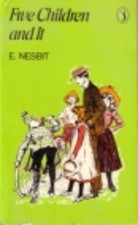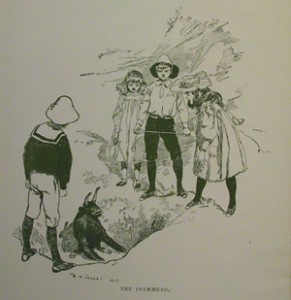‘Five Children and It’ by E. Nesbit
 What do you read when it’s dark and cold outside, it’s an hour of day which no diurnal creature is supposed to see and you have to leave your nice, warm, snug bed and venture out into the snow and ice for the pleasure of spending a day at work, that is if the train ever manages to get you there? Or, slightly less specifically, what are your comfort reads? For me, it’s classic children’s literature. Nothing perks me up quite like reading a good, old fashioned adventure story in which nothing is ever quite as important as supper. They are safe (after all, nothing ever goes drastically wrong in these books) but still exciting, moral but not preachy and humorous without being deliberately funny. Five Children and It by E. Nesbit is the epitome of these qualities for me and is probably my favourite children’s book of all time.
What do you read when it’s dark and cold outside, it’s an hour of day which no diurnal creature is supposed to see and you have to leave your nice, warm, snug bed and venture out into the snow and ice for the pleasure of spending a day at work, that is if the train ever manages to get you there? Or, slightly less specifically, what are your comfort reads? For me, it’s classic children’s literature. Nothing perks me up quite like reading a good, old fashioned adventure story in which nothing is ever quite as important as supper. They are safe (after all, nothing ever goes drastically wrong in these books) but still exciting, moral but not preachy and humorous without being deliberately funny. Five Children and It by E. Nesbit is the epitome of these qualities for me and is probably my favourite children’s book of all time.
Five Children and It tells the story of Robert, Anthea, Cyril and Jane and their baby brother, known affectionately as the Lamb. While holidaying in the country, their parents are both unexpectedly called away for various reasons, leaving the children to entertain themselves all summer. On the first day, they go to play in an old gravel pit and there they uncover a mysterious creature: a Psammead. These sand fairies have the ability to grant wishes which will last only until sunset. However, the old saying that you should be careful what you wish for proves true, and things often don’t work out quite as the children plan as their summer suddenly becomes much less dull and far more fraught with adventure.
There are so many things in this book which I find irresistible. First and foremost, I love the way that the world of the five children is completely conventional with the exception of one strange and magical thing: the Psammead. In fact, the world is so ordinary that the story seems almost believeable, and I remember spending many a day after I first encountered Five Children and It industriously searching beaches and sandpits for any burrowing sand fairies. Although the Psammead grants one wish a day for the children, everything else happens exactly as it would without the magical element. Thus when the children wish to be as beautiful as the day, neither their little brother nor the servants recognise them and they have to beg for food from neighbouring houses and they frequently get into trouble when their escapades keep them out past supper time. Even their wish that the servants won’t notice whatever they wish for, an attempt to avoid getting into trouble, only leads to more disaster and scoldings. In fact, the children’s wishes usually either don’t work out as they might have hoped or lead them into unforeseen scrapes from which they must extricate themselves without being able to explain to any grown ups about the magical happenings which have resulted in these strange situations. This makes for a far more satisfying book, in my opinion. A book that simply chronicled the successful wishes about a group of children might be entertaining if it were well written, but it would be fairly one dimensional. However, a book about wishes that backfire and wishes that aren’t necessarily what you intended is an engaging idea with endless possibilities. The pleasure in reading Five Children and It comes not so much from seeing the children enjoy the results of their wishes but in watching them deal with the unexpected but inevitable consequences of those wishes.
The story is brought to life by E. Nesbit’s wonderful narrative voice which permeates the book. She adopts a conspiratorial tone, as though she is letting the reader in on a big secret which makes the story feel even more special. Her humorous asides on every subject are a joy to read and can be appreciated just as much by adults as by children. She passes judgement on the children, on the adults around them and on grown ups outside the world of the book, but she does so in a way that is never condemning although it is accurate and astute. She invites the reader to share these opinions and so thoroughly draws you into the narrative.
 The Psammead itself is a wonderful creation. Although Nesbit calls it a fairy, it definitely isn’t what springs to mind when using the word, as you can see from H. R. Millar’s illustrations from my edition of the book. Fat and furry with eyes on the end of stalks like a snail, it is a thoroughly original creation. It is crotchety and short-tempered (although with good reason, I feel, being pestered daily by five children) and it makes a refreshing change to have an unwilling, grumpy magical creature in a children’s book, rather than one that is obliging. One could almost suspect, as the children do, that the Psammead is wilfully misinterpreting their wishes in order to land them in difficult situations deliberately. The presence of this creature certainly adds to the humour of the book and helps to make it a wonderful read.
The Psammead itself is a wonderful creation. Although Nesbit calls it a fairy, it definitely isn’t what springs to mind when using the word, as you can see from H. R. Millar’s illustrations from my edition of the book. Fat and furry with eyes on the end of stalks like a snail, it is a thoroughly original creation. It is crotchety and short-tempered (although with good reason, I feel, being pestered daily by five children) and it makes a refreshing change to have an unwilling, grumpy magical creature in a children’s book, rather than one that is obliging. One could almost suspect, as the children do, that the Psammead is wilfully misinterpreting their wishes in order to land them in difficult situations deliberately. The presence of this creature certainly adds to the humour of the book and helps to make it a wonderful read.
 Reading this book has filled me with the urge to watch the old BBC adaptation of Five Children and It. I’m sure it would look horribly out of date now, but it had a great many virtues in its day (not least of which was teaching me how to pronounce ‘Psammead’) and I’m feeling all nostalgic. Does anyone else remember it?
Reading this book has filled me with the urge to watch the old BBC adaptation of Five Children and It. I’m sure it would look horribly out of date now, but it had a great many virtues in its day (not least of which was teaching me how to pronounce ‘Psammead’) and I’m feeling all nostalgic. Does anyone else remember it?
Five Children and It by E. Nesbit. Illustrated by H. R. Millar. Published by Puffin, 1978, pp. 215. Originally published 1902.
4 Responses to “‘Five Children and It’ by E. Nesbit”
Comment from Annie
Time January 5, 2011 at 8:29 am
I love Nesbitt. I always included her in my Children’s Literature modules and the students were astounded that the woman they associated with ‘The Railway Children’ had written such wonderful fantasy novels. Personally, I go back to Noel Streatfeild. ‘Ballet Shoes’ forever.
Comment from oldenglishrose
Time January 5, 2011 at 10:01 pm
I love ‘The Railway Children’ as well, although they’re very different books. How lovely to be able to teach books like that; I hope your students enjoy it! I’d quite forgotten about ‘Ballet Shoes’, although I devoured Noel Streatfield’s books like there was no tomorrow when I was younger. I may have to see if there’s any chance I can locate my copy.
Comment from oldenglishrose
Time January 5, 2011 at 10:03 pm
Ah yes, I remember ‘The Dean’s Watch’ well. I have a copy lurking on my shelves somewhere, so I may have to dig it out for a reread sometime this year.
Comment from Laura
Time January 4, 2011 at 10:44 pm
I loved this book as a child, and I’d forgotten about it! Thank you for reminding me. Such nostalgia! My ultimate comfort read, though, will always be ‘The Dean’s Watch’ by Elizabeth Goudge.
xxx